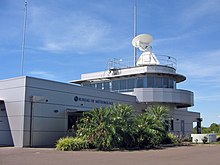Bureau of Meteorology
|
|||
|---|---|---|---|
| Position of the authority | National Meteorological Service | ||
| Supervisory authority (s) | Ministry for Environment, Heritage and the Arts | ||
| Consist | since 1906 | ||
| Headquarters | Melbourne | ||
| Authority management | Andrew Johnson (Director of Meteorology) | ||
| Website | www.bom.gov.au | ||
The Bureau of Meteorology is an executive body of the Federal Government of Australia and is responsible for providing weather forecasts for Australia and the surrounding areas.
history
The office was established in 1906 by the Meteorology Act, which merged the meteorological services that previously existed in the states and territories. The states officially handed over responsibility for recording weather events to the Bureau of Meteorology on January 1, 1908.
Services and construction

The Bureau of Meteorology reports to the Minister for Environment, Heritage and the Arts and is the primary producer of weather forecasts, warnings and observations for the Australian public. The Bureau distributes weather reports via Weather Fax and is responsible for issuing flood warnings for Australia.
The facility is headquartered in Melbourne Docklands . The Research Center, the National Meteorological and Oceanographic Center, the National Climate Center and the hydrology and satellite departments are also located there.
Regional offices are located in the state and territory capitals. Each regional office has a Regional Forecasting Center and a Flood Warning Center . The regional offices in Perth , Darwin and Brisbane also each house a Tropical Cyclone Warning Center . The Adelaide office also houses the center for forecasting the tides , while Darwin houses the warning center for volcanic ash failure .
The Australian Bureau of Meteorology is responsible for naming tropical cyclones in the waters around Australia. In previous years, a separate list was used for each of the warning centers; with the beginning of the cyclone year 2008–2009, these three lists were combined into a list of the names of tropical cyclones .
The regional offices are supported by the National Meteorological and Oceanographic Center (NMOC), the bureau's research facility, which is also based in Melbourne.
The climatological department is the National Climate Center (NCC), there are also departments for hydrology and the satellite section . The weather service also maintains a network of weather stations across the continent, on the neighboring islands and in Antarctica , plus more than 500 paid observers and around 6,000 volunteers who report amounts of rainfall.
Directors
| Organization that monitors the area on behalf of WMO | |
| Tropical Cyclone Programs | |
| pool | Responsible RSMCs * and TCWCs ** |
| North Atlantic | National Hurricane Center * (USA) |
| Eastern North Pacific | National Hurricane Center * (USA) |
| Central North Pacific | Central Pacific Hurricane Center * (USA) |
| Western North Pacific | Japan Meteorological Agency * |
| South and Southwest Pacific |
Fiji Meteorological Service * Meteorological Service of New Zealand ** Papua New Guinea National Weather Service ** Bureau of Meteorology ** (Australia) |
| Northern Ind | India Meteorological Department * |
| Southwest Indic | Météo-France La Réunion * |
| Southeast Indic |
Bureau of Meteorology ** (Australia) Meteorology and Geophysical Agency of Indonesia ** |
| director | Term of office |
|---|---|
| Henry Ambrose Hunt | 1908-1931 |
| William S. Watt | 1931-1940 |
| H. Norman Warren | 1940-1950 |
| Edward W. Timcke | 1950-1955 |
| Leonard J. Dwyer | 1955-1962 |
| William J. Gibbs | 1962-1988 |
| John Zillman | 1978-2003 |
| Geoff Love | 2003-2008 |
| Neville Smith (Acting Director) | 2008-2009 |
| Greg Ayers | 2009–? |
| Andrew Johnson |
Web links
- Official website (English)
Individual evidence
- ↑ http://www.iiasa.ac.at/web/home/about/alumni/News/160907_johnson.html
- ↑ http://www.bom.gov.au/inside/eiab/orgchart.pdf
- ^ BOM celebrates 100 years ( English ) Australian Broadcasting Corporation . January 1, 2008. Retrieved January 27, 2009.
- ^ Collections in Perth: 20. Meteorology ( English ) National Archives of Australia. Retrieved January 27, 2009.
- ^ Bureau of Meteorology Head Office 700 Collins Street ( English ) Bureau of Meteorology. Retrieved January 27, 2009.
- ^ Tropical Cyclone Names . BOM. Retrieved January 27, 2009.
- ↑ http://www.directory.gov.au/osearch.php?ou%3DNational%20Meteorological%20and%20Oceanographic%20Centre%2Cou%3DRegional%20Offices%2Cou%3DBureau%20of%20Meteorology%2Cou%3DOther%20Portfolio%20B \% 2C% 20Committees \% 2C% 20Boards% 20and% 20Councils% 2Co% 3DSustainability \% 2C% 20Environment \% 2C% 20Water \% 2C% 20Population% 20and% 20Communities% 2Co% 3DPortfolios% 2Co% 3DCommonwealth% 20of% 20A 2Cc% 3DAU & changebase National Meteorological and Oceanographic Center ( Memento of the original dated February 27, 2012 in the Internet Archive ) Info: The archive link was inserted automatically and has not yet been checked. Please check the original and archive link according to the instructions and then remove this notice. , directory.gov.au
- ↑ Atlantic Oceanographic and Meteorological Laboratory , Hurricane Research Division: Frequently Asked Questions: What regions around the globe have tropical cyclones and who is responsible for forecasting there? . NOAA . Retrieved May 31, 2008.
